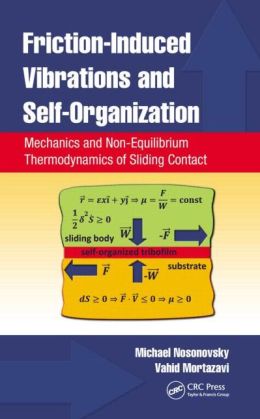 [内容简介]
[内容简介]
Many scientists and engineers do not realize that, under certain conditions, friction can lead to the formation of new structures at the interface, including in situ tribofilms and various patterns. In turn, these structures—usually formed by destabilization of the stationary sliding regime—can lead to the reduction of friction and wear. Friction-Induced Vibrations and Self-Organization: Mechanics and Non-Equilibrium Thermodynamics of Sliding Contactcombines the mechanical and thermodynamic methods in tribology, thus extending the field of mechanical friction-induced vibrations to non-mechanical instabilities and self-organization processes at the frictional interface. The book also relates friction-induced self-organization to novel biomimetic materials, such as self-lubricating, self-cleaning, and self-healing materials.
Explore Friction from a Different Angle—as a Fundamental Force of Nature
The book begins with an exploration of friction as a fundamental force of nature throughout the history of science. It then introduces general concepts related to vibrations, instabilities, and self-organization in the bulk of materials and at the interface. After presenting the principles of non-equilibrium thermodynamics as they apply to the interface, the book formulates the laws of friction and highlights important implications. The authors also analyze wear and lubrication. They then turn their attention to various types of friction-induced vibration, and practical situations and applications where these vibrations are important. The final chapters consider various types of friction-induced self-organization and how these effects can be used for novel self-lubricating, self-cleaning, and self-healing materials.
From Frictional Instabilities to Friction-Induced Self-Organization
Drawing on the authors’ original research, this book presents a new, twenty-first century perspective on friction and tribology. It shows how friction-induced instabilities and vibrations can lead to self-organized structures, and how understanding the structure–property relationships that lead to self-organization is key to designing "smart" biomimetic materials.
[目录]
Introduction: Friction as a Fundamental Force of Nature in the History of Mechanics
Historical Background
Certain Philosophical Concepts of Mechanics
Hilbert’s Sixth Problem
Noll’s Axiomatic Mechanics
P. Zhilin’s Approach
The Study of Friction
Summary
References
Vibrations and Stability at the Bulk and at the Interface
Linear Vibrations in Systems with Single, Multiple, and Infinite Number of Degrees of Freedom
Stability Analysis
Non-Linear Vibration and Stability Analysis
Bifurcations, Catastrophes, and Chaos
Multi-Scale Systems
Self-Organization: Different Types
Example: Benard Cells
Self-Organization in Tribology
Asymptotic Transition from a 3D (Bulk) to a 2D (Interface) System
Summary
References
Principles of Non-Equilibrium Thermodynamics and Friction
Thermodynamic Potentials and Equations
Irreversible Processes and Non-Equilibrium
Extremal Principles and Stability of Frictional Motion
Stability Criterion for Frictional Sliding
Summary
References
Bibliography
Fundamentals of Friction
Empirical Laws of Friction
Mechanisms of Friction
Non-Linear Character of Friction
Thermodynamics of Friction
Summary
References
Wear and Lubrication
Mechanisms of Wear
Empirical Laws of Wear
Thermodynamics of Wear: Entropy Generation and Degradation
Lubricated Contact
Summary
References
Bibliography
Friction-Induced Instabilities and Vibrations
Mechanics of Elastic Contact and Stability of Frictional Sliding
Velocity Dependency of Coefficient of Friction and Stability Criterion
Thermoelastic Instabilities
Adams–Martins Instabilities
Radiation of Elastic Waves by Friction
Interaction of Elastic Waves with Friction
Friction Reduction and Self-Organized Patterns due to Friction-Induced Vibrations
Summary
References
Bibliography
Friction-Induced Vibrations and Their Applications
Brakes and Vehicles
Music and Sound Generation
Nature
Summary
References
From Frictional Instabilities to Friction-Induced Self-Organization
Self-Organization, Instabilities, and Friction
Stability of Frictional Sliding with Coefficient of Friction Dependent on Temperature
Running-In as a Self-Organized Process
Frictional Turing Systems
Modeling of the Formation of Tribofilms
Stick–Slip Motion and Self-Organization
Summary
References
Self-Lubrication
Principles of Self-Healing and Self-Lubricating Materials
Various Approaches to Self-Lubrication
Summary
References
Outlook
Index

 新书报道
新书报道